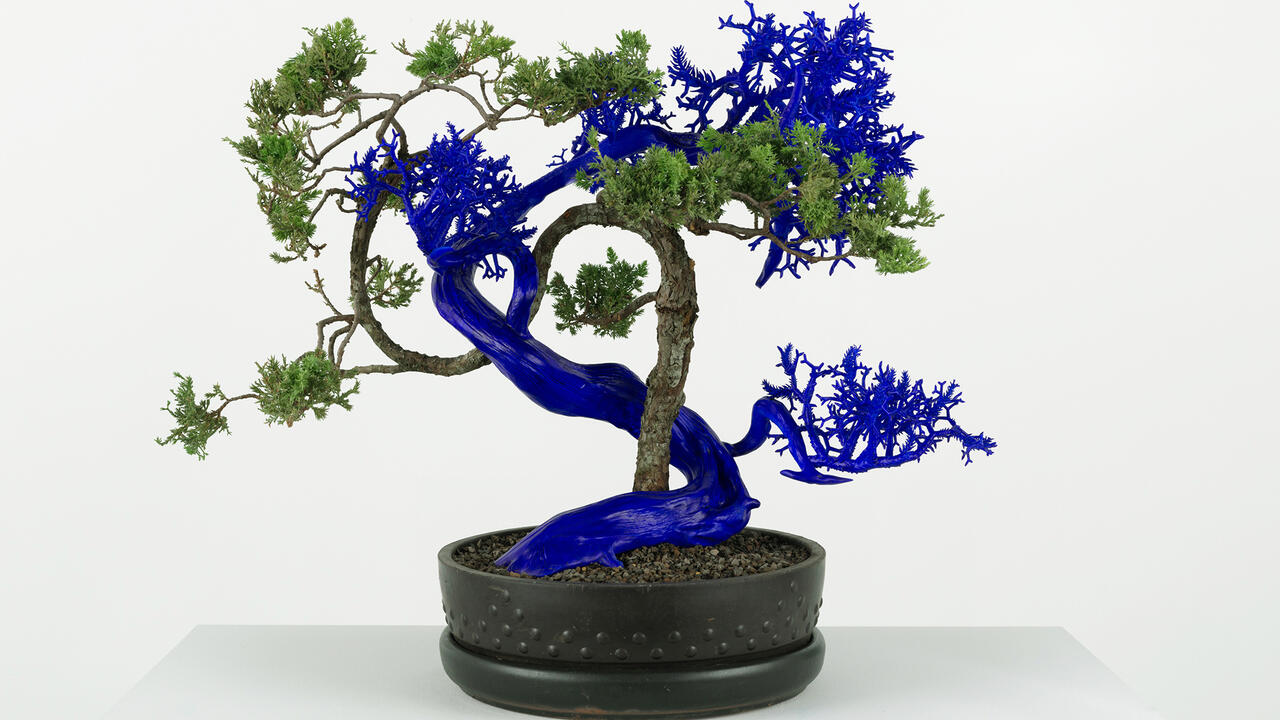Whiting Tennis
Derek Eller Gallery, New York, USA
Derek Eller Gallery, New York, USA

Whiting Tennis makes strange, somewhat stoic and brooding assemblages of found wood and corrugated cardboard. Rough-hewn and half-formed, his sculptures evoke makeshift shelters – boxy and bottom-heavy forms that rise to a half-peak, suggestive of arches, ramps or almost-roofs. Combine this basement woodshop aesthetic with often cryptic titles that trade in animal-as-talisman symbolism – White Owl or Wolf, for example – and you end up with a clubhouse of one: fiercely private curiosities offered with a kind of ‘keep out’ flavour, evoking masculinity and boyhood isolation, a silent world of pocket knives and grazed knees and gutted fish, just to see what the insides looked like. Think young-adult novels such as Jean Craighead George’s My Side of the Mountain (1959), which combined a Henry David Thoreau-like wisdom, lean-tos, perseverance and a pet falcon.
One of the smallest and best works in the show, Dead Bird (2008), is like a birdhouse in mourning, a wall-mounted box with neither entrance nor exit, painted a dull brown. It is both sentimental and gently ironic: a boarded up birdhouse, at its most basic – composed entirely of straight lines, the kind a 12-year-old might make in carpentry class, newly introduced to a bandsaw. But Dead Bird also contains a second, more meaningful level of discourse, as an anti-Joseph Cornell bird box: no doves or ramps, no lyrical paper stars or mermaids. Indeed, in its materiality and presentation Tennis’ work can be read as a nod to some of the greats of American Modernism, three-dimensional works are much larger, comprised of totemic, David-Smith-like shapes, expressive and abstract, without the permanence of the material or the clarity of intent: no bronze here or brawny Modernism, just simple plywood and raw tar, as in Boogeyman (2007), which can be interpreted as a homage to random, under-the-bed childhood monsters (with, in this case, a striking resemblance, coincidental or not, to Darth Vader) or as a homage to Louise Nevelson’s imposing black forms, which were often made of found wooden objects. The twist, of course, is in Tennis’ so-called materiality, using hot melted tar to coat his sculpture, versus the then unheard-of use of house paint first employed by the Abstract Expressionist generation of the mid-1950s. So his usage can be construed as a version of the first, rendering his sensorium another subtle level of deference. Tennis, then, trains his viewers to diminish their Postmodernist expectations, used to seeing craftiness (or the deliberate lack thereof) in the service of irony or faux-naïveté.
But these works are not ironic. If anything, they are a bit misty-eyed for a bygone chapter of Russian Constructivism, exemplified in a rather wry construction titled Eastern Block Cabinet (2008), which is rather a non-cabinet, with a deeply slanted pitch, unsuitable for storage, complete with a padlocked drawer, one supposes: a genteel representation of Communist repression and sensibility, as understood by the West (citizens ‘locked out’ of the rest of the world via censorship and limited access to goods and services). The word ‘Block’ in the title is either a mistake (for ‘Eastern Bloc’, the former Warsaw Pact countries) or a pun, denoting the ‘blockiness’ of timber as a material.
These blocky properties are particularly exaggerated in one of the best sculptures, Study for Pharaoh (2007), which combines the idea of a stepped pyramid with a sarcophagus-like form, simplifying the mummy and its architecture into a portable, mobile unit. The whole construction is stellar in that the stepped structure is actually a found lath, a basic building form meant to give structural reinforcement to a wall through a lattice or striped pattern.
Tennis has also produced paintings and drawings, which are collage-like, a nod to Kurt Schwitters’ Merzbau (1933–43), with his worldview of a total work of art, built continuously. Tennis works cumulatively as well, often collaging cardboard and bits of detritus on paper, either as a study for a later sculpture or as an extension of an idea itself, such as a rather futuristic Birdbath (2007), one of the few paintings in the show, a straightforward oil on canvas that looks less like a birdbath than like industrial-sized tubing. These works, however, are less resolved and less interesting than the overall effect of the sculptures as anti-grandiose and rather pathos-inducing.
























